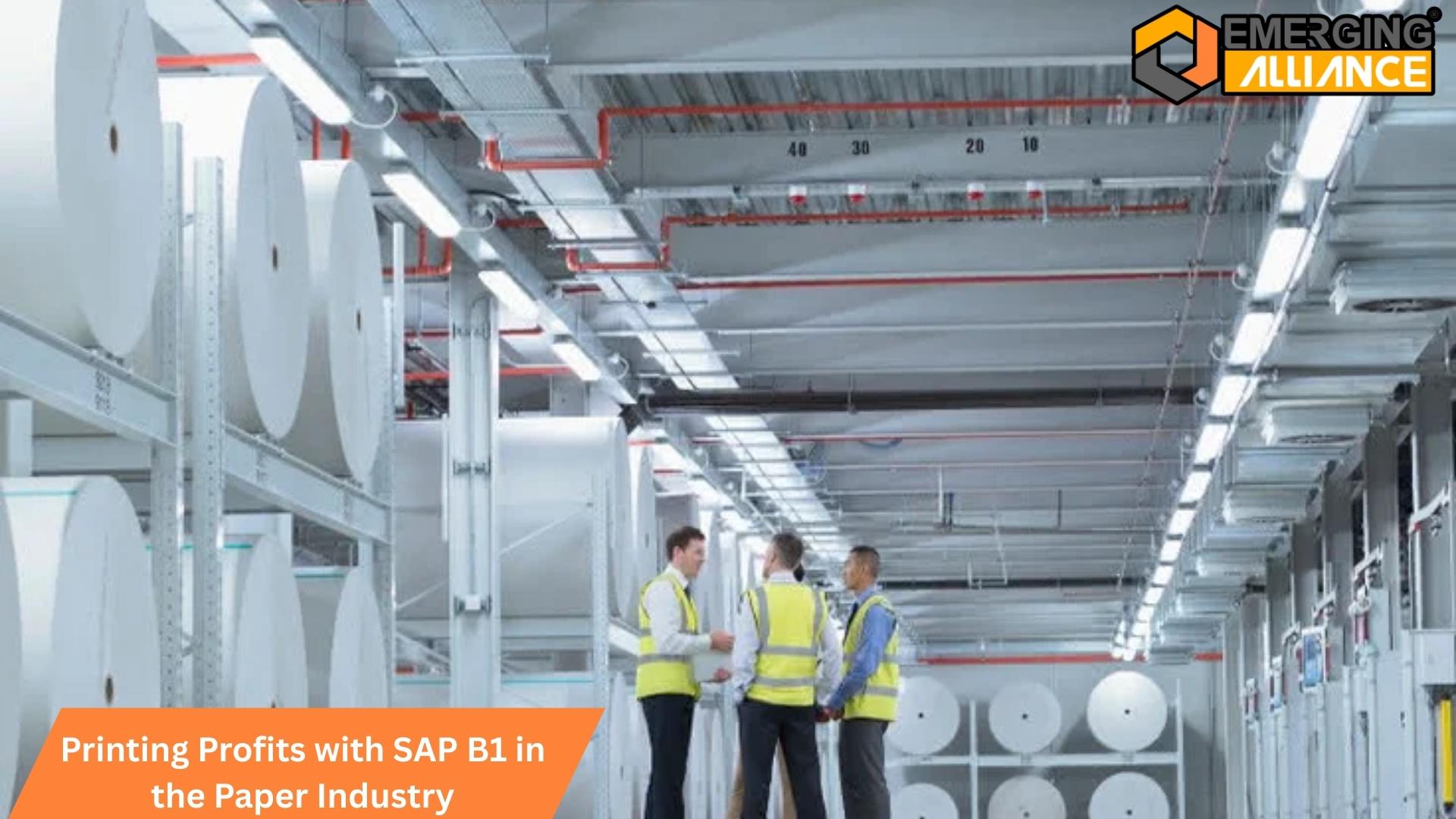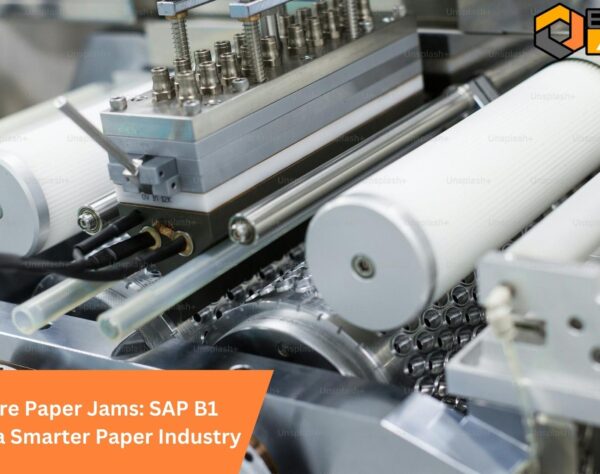
Printing Profits with SAP B1 in the Paper Industry

Rolling Out Success: How SAP B1 Transforms the Paper Industry
In a world where digital transformation is rapidly redefining industries, the paper industry is no exception. Paper manufacturers are facing multiple challenges — fluctuating raw material costs, growing pressure to adopt sustainable practices, and the need to streamline operations to stay competitive. As customer expectations rise and compliance requirements tighten, staying ahead demands more than just traditional methods. This is where SAP B1 (SAP Business One) emerges as a powerful solution, driving efficiency, reducing waste, and enhancing profitability in the paper industry.
SAP B1 is more than just an ERP system — it’s a comprehensive business management solution that automates critical processes, offers real-time insights, and empowers paper manufacturers to make data-driven decisions. Whether you’re producing newsprint, packaging materials, or specialty paper, SAP Business One enables you to optimize every aspect of your business, from procurement and production to quality control and customer satisfaction.
Why the Paper Industry Needs SAP B1 Now More Than Ever
1. Tackling Complex Supply Chain Challenges
The paper industry relies on an intricate supply chain, where even minor delays can disrupt production timelines. Procuring raw materials such as wood pulp, chemicals, and adhesives requires careful planning and tracking. SAP B1 centralizes supply chain data, automates order processing, and monitors vendor performance in real time. This reduces procurement errors and ensures raw materials arrive on time, minimizing downtime and enhancing production efficiency.
✅ Example: A leading packaging paper manufacturer streamlined its supply chain by adopting SAP B1, reducing raw material procurement delays by 20% and lowering costs associated with inventory mismanagement.
2. Streamlining Production for Maximum Efficiency
Paper production involves multiple stages, each requiring precise control over raw materials, production schedules, and quality standards. SAP Business One introduces automated production planning that eliminates manual errors, optimizes machine usage, and minimizes downtime. By analyzing historical data, SAP B1 identifies production bottlenecks and suggests improvements that lead to consistent product quality and higher output.
✅ Success Story: A mid-sized paper mill achieved a 15% increase in production efficiency after implementing SAP B1’s intelligent scheduling and resource allocation capabilities.
3. Enhancing Quality Control and Compliance
Consistency in quality is paramount in the paper industry, where defects can lead to product recalls, customer dissatisfaction, and regulatory penalties. SAP B1 provides real-time quality monitoring and batch traceability, ensuring that each production cycle adheres to defined standards. The system automatically generates compliance reports, helping manufacturers maintain transparency and meet international regulations.
✅ Highlight: A specialty paper company reduced defect rates by 22% by using SAP B1’s real-time quality control and compliance tracking features.
4. Smart Inventory and Warehouse Management
Overstocking leads to increased storage costs, while stockouts disrupt production and affect customer satisfaction. SAP B1 ensures optimal inventory levels through automated demand forecasting and smart replenishment strategies. With real-time updates on stock movements, manufacturers can prevent dead inventory and avoid excess holding costs.
✅ Case Study: A paper distributor reduced warehouse expenses by 18% after integrating SAP B1’s intelligent inventory controls, leading to improved stock visibility and faster order fulfillment.
5. Financial Visibility and Profit Maximization
Profitability in the paper industry hinges on controlling operational costs and optimizing resource utilization. SAP Business One provides advanced financial management tools that offer detailed insights into revenue streams, cost structures, and margins. By automating financial processes and generating real-time reports, SAP B1 empowers decision-makers to identify areas of improvement and take corrective actions promptly.
✅ Insight: Paper manufacturers using SAP B1 reported a 14% increase in overall profit margins due to improved financial forecasting and cost management.
Key SAP B1 Features Empowering the Paper Industry
1. Advanced Material Requirement Planning (MRP)
Plan and schedule production efficiently by forecasting demand and ensuring timely procurement of raw materials.
2. Batch and Lot Traceability
Track raw materials and finished products throughout the supply chain, ensuring quality control and compliance.
3. Vendor Performance Analytics
Evaluate supplier reliability, monitor procurement cycles, and maintain a steady supply of raw materials.
4. Real-Time Production Analytics
Get instant insights into machine utilization, production efficiency, and downtime to enhance operational performance.
5. Dynamic CRM Integration
Improve customer relationships through personalized service, better order tracking, and prompt resolution of inquiries.
How SAP B1 Boosts Profitability in the Paper Industry
1. Automating Repetitive Processes for Efficiency
Manual workflows, such as order processing, invoicing, and compliance documentation, are time-consuming and prone to errors. SAP B1 automates these tasks, minimizing manual intervention and allowing staff to focus on value-added activities. This not only increases operational speed but also reduces the risk of costly mistakes.
2. Minimizing Waste Through Precision Planning
Waste reduction is a priority in the paper industry, where excess raw material usage and inefficient production schedules can erode profit margins. SAP B1 uses predictive analytics and data-driven demand forecasting to minimize waste, optimize raw material consumption, and align production schedules with customer demand.
3. Strengthening Customer Relationships with Enhanced CRM
In the paper industry, customer loyalty is built on delivering consistent quality, timely deliveries, and responsive customer service. SAP B1 includes an integrated CRM module that allows businesses to manage customer interactions, track order histories, and deliver personalized services. This fosters stronger customer relationships and improves satisfaction rates.
4. Enabling Data-Driven Decision-Making
Timely and informed decision-making is critical for maintaining a competitive edge. SAP Business One equips business leaders with real-time analytics and financial insights, enabling them to identify operational inefficiencies, reduce costs, and maximize profitability. With SAP B1, companies can pivot quickly to adapt to market changes and emerging trends.
The Competitive Edge: Why SAP B1 is a Game-Changer for Paper Manufacturers
By integrating every aspect of operations — from procurement and production to sales and financials — SAP B1 empowers paper manufacturers with a 360-degree view of their business. Its ability to scale effortlessly ensures that companies remain agile and responsive to market dynamics. Whether expanding production lines or entering new markets, SAP B1 adapts to business growth without compromising operational efficiency.
Final Thoughts: Paper Industry Profitability with SAP B1
As the paper industry adapts to evolving market demands and increasing customer expectations, the need for a reliable, scalable, and efficient ERP solution has never been greater. SAP Business One provides paper manufacturers with the tools they need to streamline processes, ensure compliance, and maximize profitability. With its ability to integrate seamlessly across departments and provide real-time insights, SAP B1 positions paper companies to navigate challenges, seize new opportunities, and stay ahead in a competitive marketplace.
If your goal is to enhance operational efficiency, reduce waste, and drive long-term growth in the paper industry, it’s time to explore the full potential of SAP B1. Start your transformation today and roll out success with SAP Business One.
FAQs
1. How does SAP B1 improve supply chain efficiency in the paper industry?
SAP B1 centralizes supply chain data, automates order processing, and tracks vendor performance, ensuring smooth procurement and reduced delays.
2. Can SAP B1 help paper manufacturers comply with regulatory standards?
Yes, SAP B1 generates audit-ready reports, monitors compliance standards, and ensures adherence to industry regulations.
3. How does SAP B1 minimize waste in the paper production process?
SAP B1 leverages demand forecasting and production planning to optimize raw material usage and reduce waste.
4. Does SAP B1 provide real-time insights for decision-making?
Absolutely. SAP B1 offers real-time financial, operational, and production insights that enable informed decision-making.
5. Can SAP B1 integrate with existing systems used by paper manufacturers?
Yes, SAP B1 integrates seamlessly with existing CRMs, warehouse management systems, and third-party applications.
6. How does SAP B1 enhance customer satisfaction in the paper industry?
By enabling personalized services, tracking order histories, and ensuring faster responses, SAP B1 enhances customer relationships.
7. Is SAP B1 scalable for growing paper businesses?
Yes, SAP B1 scales easily, supporting business growth, increased production lines, and expansion into new markets.
8. What are the financial management benefits of SAP B1 for paper companies?
SAP B1 provides cost analysis, revenue tracking, and profitability monitoring, enabling paper companies to optimize their financials.
9. How long does it take to implement SAP B1 for a paper manufacturing company?
Implementation timelines vary based on business complexity but typically range from 3 to 6 months.
10. Does SAP B1 support batch tracking for quality control in the paper industry?
Yes, SAP B1 offers batch traceability to monitor raw materials and finished goods, ensuring consistent quality standards.




